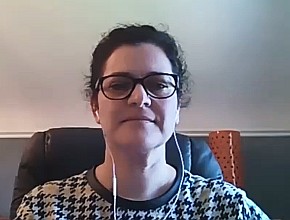Dr Dominik Mertz, associate professor in the Division of Infectious Diseases at McMaster University and medical director of infection prevention and control at Hamilton Health Sciences, joins Dr Roman Jaeschke to discuss the current COVID-19 situation worldwide.
For part 2 of the interview, click here.
Roman Jaeschke, MD, MSc: Good afternoon, welcome to another edition of McMaster Perspective. It’s my pleasure to introduce Associate Professor Dr Dominik Mertz, working at Hamilton Health Sciences as an infectious disease specialist. Dominik is originally from Switzerland and became recently our local, provincial, national, and increasingly international expert in coronavirus disease 2019 (COVID-19). He is educating McMaster faculty on COVID-related issues.
Dominik, why don’t we start from epidemiology. Where do we stand these days?
Dominik Mertz, MD, MSc: Thanks, Roman, for having me today. Where are we standing? I would say globally we are still in the middle of the first wave. It’s not that we had a huge wave across the globe at some point of time, which goes away and then the second wave starts. But we certainly see that up and down at the national level.
When you’re comparing the countries, you see very different shapes of those epidemic (epi) curves; the Canadian one, obviously, had a peak in the beginning of April and has been since more or less stable. It seems to be peaking up again now over summer.
The United States, for example, had the first wave or first peak at the national level around the same time, but it never went down as much. Now they are in the middle or—what it looks like currently—more at the end of a second peak, but it’s basically still the first wave. It’s not that it pretty much disappeared in between; it just kept going.
But when you’re looking at the state level, then you will see New York had a very clear first wave and very low numbers ever since. And all the states in the Sunbelt—Louisiana, Florida, and so on—they had a very minor first peak when New York had this major peak, but now they’ve had a very large peak that they are currently recovering from. So it looks very different across the world.
Africa, for example, sees a very delayed spread and it is not as significant as people were concerned about initially. South America, as you know, was also pretty much spared in the beginning and now, over summer, they saw and still see a very significant peak with many countries, with the case counts still going up from day to day. So it’s certainly not that there was one global wave that disappeared. It’s going up and down in different paces and in different shapes across the globe.
Roman Jaeschke: But looking at the global picture, we are still more or less in the plateau after the first peak, and probably certain countries are contributing more or less at any given time. Any explanation of why it is happening? Is it an issue of population? Is it an issue of density? People were expecting dramatic things in Africa and they didn’t happen, at least so far.
Dominik Mertz: I think Africa is very interesting and people don’t fully understand yet why that’s the case. Some people would start with probably the most difficult or contentious hypothesis, which is that of some level of cross-immunity with other coronaviruses. Some people would argue that because the other viruses spread [there] more easily as well, Africa may have some level of what some people would refer to as “dark matter” or cross-immunity, typically the T-cell immunity system. They hypothesize that may protect them much better than in other regions. The counterargument to that is that you would probably see a similar picture in South America, which you actually don’t. So I’m not convinced that’s really the case.
Roman Jaeschke: It will give us a topic to discuss again.
The other big issue epidemiologically is the disconnect between the number of cases appearing now in certain countries and expected mortality. The mortality seemed to be minimal in comparison to the number of cases in some areas of the world at least. Any explanations for that?
Dominik Mertz: There’s multiple explanations. Some you can confirm, or confirm their opposite, over time. The first one that people would always say at the beginning of a peak, when you don’t see those numbers of deaths going up yet, is that there’s a delay between the onset of symptoms or, at the population level, the number of cases and an increase in the number of deaths.
This being said, there are several regions now, in particular in Europe but also in the United States to some extent, where we haven’t seen that level of mortality happening that we would have expected from what we’ve seen earlier in the pandemic, thinking about New York City or also northern Italy.
An important aspect there is probably just the age group that’s currently mostly affected. I think most nations are doing a much better job in protecting the elderly and vulnerable population, so we see less deaths in those populations. Currently, at least in the Western Hemisphere, it’s the 20- and 30-year-olds that are the most common population that gets infected, and they don’t get as many complications, obviously, as the 70-, 80-, or 90-year-olds. So that’s certainly an important piece in there.
When you talk about mortality rates, it’s very important to break it down by age groups, because those differences are massive.
Roman Jaeschke: Is it possible that the virus mutates?
Dominik Mertz: It does mutate but relatively slowly [and] there’s no major changes so far. I haven’t seen any data that really suggests that it’s the virus changing due to mutations that makes it less pathogenic. I think it would probably be the best thing for us if that happened, because if we had a milder form of this coronavirus—sort of taking over from the other strains—and if we were building up our immunity being exposed to a milder version of this virus, from a population perspective that would be the best. But I haven’t seen any evidence yet of this happening.
If anything, it looks that the virus doesn’t mutate as significantly, which on the other hand is good news in terms of the development of vaccines, because it doesn’t look like the targets of the vaccine really mutate as quickly as some people might have been concerned about.
Roman Jaeschke: That would be good news, obviously.
The other big issue, and I’m not sure whether I got the terminology right, is between infected people and symptomatic people. Is it possible that we are detecting more people who are asymptomatic or nonsymptomatic at all?
Dominik Mertz: I think that’s another explanation. When you’re looking at, for example, France, where they clearly are in their second peak right now, based on case numbers, I think they are roughly at double the number of cases compared with peak one. But nevertheless, as you mentioned, we haven’t seen a mortality signal yet. Based on what I’ve heard, they do not even have nearly as many hospitalized patients [as] during the first peak.
One other explanation, other than the ones we talked about, certainly is that with the ramping up of the testing and the testing capacity and the less strict criteria to testing, I’m confident that most countries at this point are capturing many more cases or a much larger proportion of all cases than we did back in March and April. Whatever we saw back then, say, 100 cases then, in truth were maybe 1000 or 2000 cases, depending on the jurisdiction.
Roman Jaeschke: But we were detecting [only] the most severe cases?
Dominik Mertz: Exactly. But now when we have 100 cases [detected], it may in truth only be 300, 400, or 500 cases in total because we are doing more testing.
Roman Jaeschke: Maybe the last question in this segment. There are more and more data about serology, about people who had contact [with the virus] or were infected. Could you comment on the magnitude of this issue?
Dominik Mertz: We get more and more serology studies in now, and there are still limitations in terms of accuracy of those tests. Many studies have adjusted for false positives, false negatives, and so on. But I think as a crude measure, they help us a lot to understand how many cases we may have missed with our nasopharyngeal swab (NPS) testing, the polymerase chain reaction (PCR) testing that we have been doing.
Also, it doesn’t look like there’s an entirely clear trend that we capture more over time. I feel like more and more we do see that trend. Early on, the small serology tests or studies would have shown that most jurisdictions may have missed or missed 19 out of 20 cases. So they only picked up 1 in 20. In the meantime, when you look at the paper from Iceland published at the end of August, they actually picked up half of all cases. In Ontario, it looks like we were in the range of 1 in 4 to 1 in 5 in June and British Columbia was 1 in 10. So it looks like nowadays probably most jurisdictions would pick up somewhere between 1 in 5 to 1 in 10 cases.
This being said, the ones you pick up are typically the most severe cases, obviously, because those are the people who seek testing or require hospital care. You always have an underrepresentation of the mild symptoms and the asymptomatics. And it currently looks like probably around 1 in 5 individuals remain asymptomatic. Unless you do a lot of testing, you will never pick them up, but you will pick them up with serology eventually.
Roman Jaeschke: So this would have a good implication for the estimation of mortality or case fatality rates, or how many of those who get infected would die. Effectively, it would decrease it by anywhere from 2- to 10-fold. [Those are] our estimates. Is that correct thinking?
Dominik Mertz: Yeah, that’s correct. When we’re looking at the case fatality rates or ratios which are based on the confirmed cases—our PCR cases—even in the United States they currently have one of the lowest case fatality rates, probably because they pick up that many cases as one of the explanations; they are sitting at around 3%. Northern Italy back then had around a 15% to 20% case fatality rate, but probably because they were only able to pick up that very small portion of the iceberg.
Once you compare those case fatality rates across nations, you see wide ranges, which probably cannot be explained just by differences in population. Then it really goes down to, “What’s the proportion of the iceberg that you actually see?” And serology certainly helps you there to get a better estimate—and it is an estimate, again, of today, and we need to be aware of that—of the true extent of the infection. Once you use that as a denominator, there’s much less differences from nation to nation than what we see with these fatality rates.
Roman Jaeschke: Thank you very much for this part of the interview. We’ll return to talk about how to decrease the number of people infected. We’ll talk about schools and air travel and vaccination, but that’s in the next segment. Thank you very much for this.
Dominik Mertz: Thanks, Roman.
 English
English
 Español
Español
 українська
українська











